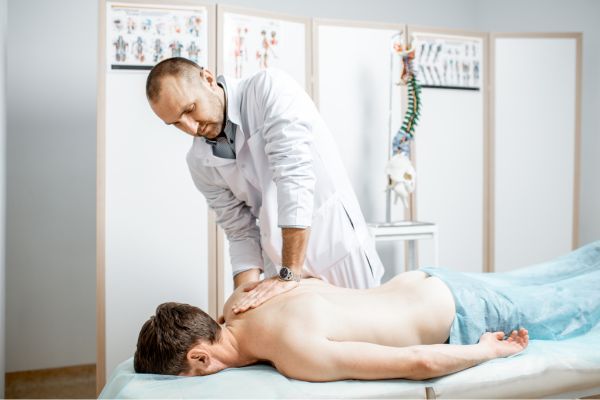Thoracic back pain refers to discomfort or pain that originates in the middle portion of the spine. This type of pain can be caused by various factors such as poor posture, muscle imbalances, or spinal conditions. Dynafisio, a renowned physiotherapy clinic in Gurgaon, specializes in providing effective physiotherapy treatment for thoracic back pain.
Our experienced physiotherapists employ a holistic approach to treat thoracic back pain. We use a combination manual therapy of techniques, targeted exercises, and posture correction to alleviate pain, improve mobility, and enhance overall spinal health. If you are struggling with thoracic back pain, contact Dynafisio today for personalized physiotherapy treatment in Gurgaon. Let us help you reclaim your life without the burden of thoracic back pain.
Thoracic back pain refers to discomfort or pain in the middle portion of the spine, known as the thoracic region. If you are experiencing thoracic back pain in Gurgaon, it's important to recognize the symptoms that may accompany it. Common symptoms of thoracic back pain include localized pain or tenderness in the middle or upper back, muscle tightness or stiffness, difficulty in maintaining proper posture, and limited range of motion. In some cases, thoracic back pain may also be associated with radiating pain or numbness in the arms or chest. If you are experiencing any of these symptoms, it is advisable to seek professional evaluation and treatment from the best physiotherapist in Gurgaon.
Diagnosing thoracic back pain involves a comprehensive evaluation by a qualified healthcare professional, such as a physiotherapist or an orthopedic specialist. Several methods may be used to diagnose the underlying cause of thoracic back pain.
Firstly, a thorough medical history is obtained, followed by a physical examination, which includes assessing posture, range of motion, and muscle strength. Diagnostic imaging tests, such as X-rays, CT scans, or MRI scans, may be ordered to visualize the structures of the thoracic spine and identify any abnormalities or injuries.
In some cases, nerve conduction studies or electromyography may be conducted to evaluate nerve function and identify potential nerve compression. Based on the clinical findings, an accurate diagnosis can be made, allowing for appropriate and individualized treatment planning.

Physiotherapy treatment for thoracic back pain focuses on addressing the underlying causes of the pain and promoting healing and relief. A qualified physiotherapist will perform a thorough assessment to understand the specific factors contributing to the pain. They may use various techniques to relieve pain and improve mobility. Manual therapy techniques such as joint mobilization, soft tissue mobilization, and myofascial release are commonly used to target tight muscles, release tension, and restore proper alignment. These techniques aim to reduce pain and increase joint and muscle flexibility.
Exercise therapy plays a vital role in thoracic back pain treatment. Strengthening exercises are prescribed to target weak muscles and promote stability, while stretching exercises help improve flexibility and reduce muscle tightness. Posture correction exercises are also important to address poor posture, a common contributor to thoracic back pain. In addition to manual therapy and exercise, other modalities may be utilized to complement treatment, such as heat or cold therapy, ultrasound, or electrotherapy. These modalities can help reduce pain, inflammation, and muscle spasms.
Education and self-management strategies are essential components of thoracic back pain physiotherapy. Patients are educated on ergonomic principles, posture correction techniques, and lifestyle modifications to prevent pain recurrence and promote long-term spine health. Overall, a comprehensive physiotherapy treatment approach for thoracic back pain aims to alleviate pain, improve flexibility and strength, correct posture, and empower individuals to manage their condition effectively. Consult a qualified physiotherapist for personalized treatment based on your specific needs and goals.
If you're experiencing thoracic back pain, seek professional help. Our dedicated team of physiotherapists specializes in treating thoracic back pain using advanced techniques and personalized care. Don't let back pain hold you back - schedule an appointment at Best physiotherapy clinic in Gurgaon, and start your journey to a pain-free back today.